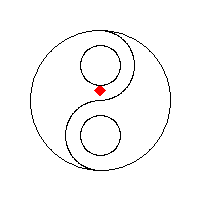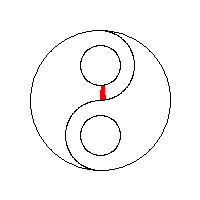- Java 双重比较
- java - 比较器与 Apache BeanComparator
- Objective-C 完成 block 导致额外的方法调用?
- database - RESTful URI 是否应该公开数据库主键?
我正在开发一款游戏(并且已经问了几个关于它的问题),现在我有另一个问题要问你们。
此游戏中的关卡格式设置为 Uint16 的瓦片图(我使用的是 SDL),它们是瓦片数据结构数组的索引。 tilemapData 结构的位之一是 isConductive 位/ bool 值。
该位的用途基本上是创建将各种对象连接在一起形成单个“powerNet”的路径。我在下面有一些关于当前方法的代码(有效,但我会在之后解释为什么我真的很讨厌它)
void findSetPoweredObjects(unsigned long x, unsigned long y, powerNetInfo * powerNet) {
//Look for poweredObjs on this tile and set their powerNet to the given powernet
for (int i = 0; i < level->numChunks[CHUNKTYPE_POWEREDDEF]; i++)
if (level->poweredObjects[i]->position[0] == x && level->poweredObjects[i]->position[1] == y)
level->poweredObjects[i]->powerNet = powerNet, powerNet->objectsInNet++;
}
void recursiveCheckTile(bool * isWalked, powerNetInfo * powerNet, unsigned long x, unsigned long y, tilemapData * levelMap) {
//If out of bounds, return
if (x < 0 || y < 0 || x >= level->mapDimensions[0] || y >= level->mapDimensions[1]) return;
//If tile already walked, return
if (isWalked[x + (y * level->mapDimensions[0])]) return;
//If tile is nonconductive, return
if (!(level->tiles[levelMap->map[x + (y * level->mapDimensions[0])]]->flags & TILETYPE_CONDUCTIVE)) return;
//Valid tile to check, see if there's a poweredobj on the tile (link it to the net if it is) and check the adjacent tiles.
isWalked[x + (y * level->mapDimensions[0])] = true;
findSetPoweredObjects(x,y,powerNet);
recursiveCheckTile(isWalked, powerNet, x - 1, y, levelMap);
recursiveCheckTile(isWalked, powerNet, x + 1, y, levelMap);
recursiveCheckTile(isWalked, powerNet, x, y - 1, levelMap);
recursiveCheckTile(isWalked, powerNet, x, y + 1, levelMap);
}
bool buildPowerNets(void) {
//Build the powernets used by the powered objects
//TODO: Rewrite buildPowerNets() & recursiveCheckTile() to avoid stack overflows and make it easier to backtrace powernets in-game
bool * isWalked;
isWalked = new bool[(level->mapDimensions[0] * level->mapDimensions[1])];
unsigned long x, y;
tilemapData * levelMap = level->layers[level->activeMap];
for (y = 0; y < level->mapDimensions[1]; y++) {
for (x = 0; x < level->mapDimensions[0]; x++) {
if (isWalked[x + (y * level->mapDimensions[0])]) continue;
isWalked[x + (y * level->mapDimensions[0])] = true;
if (level->tiles[levelMap->map[x + (y * level->mapDimensions[0])]]->flags & TILETYPE_CONDUCTIVE) {
//it's conductive, find out what it's connected to.
//But first, create a new powernet
powerNetInfo * powerNet = new powerNetInfo;
powerNet->objectsInNet = 0;
powerNet->producerId = -1;
powerNet->supplyType = POWER_OFF;
powerNet->prevSupplyType = POWER_OFF;
powerNet->powerFor = 0;
//Find adjacent tiles to this one, add them to it's powernet, and then mark them walked. Then repeat until the net is done.
recursiveCheckTile(isWalked, powerNet, x, y, levelMap);
}
}
}
delete isWalked;
for (int i = 0; i < level->numChunks[CHUNKTYPE_POWEREDDEF]; i++)
if (level->poweredObjects[i]->powerNet == NULL) return false;
return true;
}
请注意,返回 false 意味着函数失败(在这种情况下,它没有正确链接所有对象)。
我担心的是,由于堆栈溢出,在更复杂的 map 上行走导电砖的功能会完全失败。关于如何通过这些功能降低这种风险有哪些想法?如果需要,我可以提供有关所用结构的更多信息。
我考虑过修改代码,使 recursiveCheckTile 仅在到达交界处时进行递归调用,并且只是交互地遵循它所在的导电路径,但这似乎仍然只是一个部分解决方案,因为我无法提前知道路径可能有多扭曲或分支。
如果它有所不同,速度在这里完全不重要,因为这个函数只在 map 使用前处理时运行一次,所以多花点时间也没什么坏处。
最佳答案
看起来你基本上是在做 flood fill你的网格。您可以通过使用需要检查的队列或一堆方 block 来消除递归。查看"alternate implementations" section伪代码的维基百科文章。
自己维护队列/堆栈的优点是,当您访问它们时,您将从列表中删除方 block ,而在递归解决方案中,即使在您访问它们之后,方 block 仍保留在堆栈中。
这是维基百科文章中适合您的问题的“简单”替代实现:
1. Set Q to the empty queue.
2. Add node to the end of Q.
3. While Q is not empty:
4. Set n equal to the first element of Q
5. Remove first element from Q
6. If n has already been visited:
7. Go back to step 3.
8. Mark n as visited.
9. Add the node to the west to the end of Q.
10. Add the node to the east to the end of Q.
11. Add the node to the north to the end of Q.
12. Add the node to the south to the end of Q.
13. Return.
请注意,您可以为此使用堆栈或队列,两者都可以。这里有一些很酷且令人着迷的动画,从视觉上展示了差异:


您还可以找到 connected component labeling如果您最终在同一个网格上拥有多个电网,这个页面很有趣。它基本上可以帮助您确定是否有多个断开的电源网络,当您这样做时,它会告诉您每个方格属于哪一个。

关于c++ - 映射分支瓦片路径,我们在Stack Overflow上找到一个类似的问题: https://stackoverflow.com/questions/1175600/
BufferedImage image = ImageIO.read(SpriteSheet.class.getResource(path)); BufferedImage image = Image
希望有人能够帮助我解决将我的 React 应用程序推送到 Heroku 时遇到的问题。 heroku 日志反复显示以下错误。 at=error code=H10 desc="App crashed"
我是 Kotlin 的新手,我正在经历这样的例子。 . . package com.example.lambda1 import spark.Spark.get fun main(args: Arra
如果您已经安装了 32 位 JDK,请在中定义一个 JAVA_HOME 变量 Computer>System Properties>System Setting>Enviorment VAriable
我正在开发一个独立于平台的应用程序。我收到一个文件 URL*。在 Windows 上,这些是: file:///Z:/folder%20to%20file/file.txt file://host/f
我在 OSX、Objective-C 上。 我有一个像 这样的路径/NSURL /Users/xxx/Desktop/image2.png 但我将它传递给第三方应用程序,该应用程序会像 excpect
我已经安装了 Android studio 和插件的 DART,FLUTTER 来启动 flutter,但是因为我在创建我的第一个 flutter 项目时无法提供 sdk 路径。 最佳答案 我试图找出
127.0.0.1:8000/api/仅包含来自第二个应用程序的 url,但我将两个 url 模块链接到相同的模式。甚至有可能做到这一点吗? 第一个应用程序: from django.urls imp
对于大量图像(大约 1k,加上相同数量的拇指,在大约 500 个文件夹中),我们要求网站上使用的所有图像 URI 都必须具有 SEO 优化路径。它们已经准备好并提供完整的路径结构(每个文件夹包含一个具
为什么 f 不是一个文件?什么可能导致这种情况? String currentPhotoPath = "file:/storage/sdcard0/Pictures/someFileName.
Gradle 中的项目名称或路径中允许使用哪些字符? 它是否与特定操作系统的目录名称中允许的字符相同(例如: http://en.wikipedia.org/wiki/Filename#Reserve
我有一个包含文件夹路径的表格。我需要找到层次结构中这些文件夹之间的所有“差距”。我的意思是,如果表格包含这 3 个文件夹: 'A' 'A\B\C' 'A\B\C\D\E\F\G' 我需要在层次结构中找
我在 Linux 服务器上的/home/subversion 中安装了 svn - 那里有一个 ROOT 文件夹,其中包含 db 和 conf 等文件夹。没有映射到项目名称的文件夹,请有人告诉我如何列
对于我的图像位置:/src/assets/bitmap/sample.jpg 给出了关键配置: context: resolve('src') output: { path: resolve('b
我需要创建带有圆角的 SVG 路径,以将它们导出到 DXF 进行切割。我的问题是角应该是圆弧,而不是贝塞尔曲线。 使用 arc 命令相对容易处理直角,因为半径也是从拐角到圆弧起点的距离。对于其他角度,
大家好,我正在玩 Airflow,我正在阅读这篇很有帮助的 tutorial .我正在寻求帮助以更好地了解 Admin->Connection 如何在 Conn Type: File (path) 方
我的目标是定义R将用于安装和搜索库的单个路径。我read可以通过更改Rprofile.site安装路径中的R文件来完成。我在那里尝试了两个命令: .libPaths("D:/RLibrary") .L
我有一个问题:当我在一个页面中时,我想返回到上一页。我使用 $routeProvider。如何读取之前的 url? 我尝试在我的 Controller 中使用此代码但不起作用... angular.m
我正在尝试将一个文件从我的主干合并到一个分支(wc),并且对于看起来位于当前合并操作中不涉及的分支上的路径出现奇怪的未找到路径错误。 例如,在我们的 svn 项目中,我们有: 分行 分支 0 分支 1
我有一个树数据序列化如下: 关系:P到C是“一对多”,C到P是“一对一”。所以列 P 可能有重复的值,但列 C 有唯一的值。 P, C 1, 2 1, 3 3, 4 2, 5 4, 6 # in da

我是一名优秀的程序员,十分优秀!